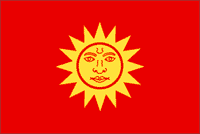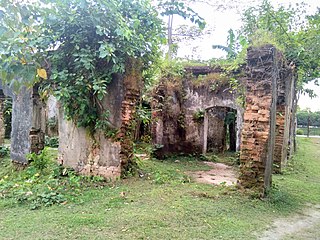
Bongaigaon district (Prpn:ˈbɒŋgaɪˌgãʊ) is an administrative district in the state of Assam in northeastern India. The district headquarters are located at Bongaigaon. The district occupies an area of 1,093 km2.

Cooch Behar, also known as Koch Bihar, was a princely state in India during the British Raj. The state was placed under the Bengal States Agency, part of the Eastern States Agency of the Bengal Presidency. It was located south of the Himalayan kingdom of Bhutan, in present-day West Bengal.

The Koch dynasty ruled parts of eastern Indian subcontinent in present-day Assam and Bengal. Biswa Singha established power in the erstwhile Kamata Kingdom which had emerged from the decaying Kamarupa Kingdom. The dynasty came to power by removing the Baro-Bhuyans, who had earlier removed the short-lived rule established by Alauddin Hussain Shah.
Abhayapuri is a town in Bongaigaon district and 21 km away from Bongaigaon city. It is the headquarters of North Salmara sub-division. It is surrounded by natural forests and hills, and is located on the National Highway 31, about 200 km west of Guwahati. Its nearest airport is at Azara, Guwahati and at Rupsi and nearest railway station is Abhayapuri Railway Station.
Sapatgram is a town and a Municipality Board Area in Dhubri district in the Indian state of Assam.

Bhawal Estate was a large zamindari in Bengal until it was abolished according to East Bengal State Acquisition and Tenancy Act of 1950.

Kaliganj is an upazila of the Lalmonirhat District in Rangpur Division, Bangladesh.

The Tekari Raj was a zamindari estate of the Bhumihar Brahmin community in South Bihar. They controlled 2,046 villages on their estate, which covered a 7,500 square kilometres (2,900 sq mi) area, near to the town of Gaya.

Natore Rajbari was a royal palace in Natore, Bangladesh. It was the residence and seat of the Rajshahi Raj family of zamindars. The famous queen Rani Bhabani lived here and after the death of her husband, expanded both the estate and the palace.

The Raikut family was a princely family that controlled large estates in Jalpaiguri what is now West Bengal, India, first as subjects to the state of Koch Bihar, later as Zamindars to the Mughal rulers of Bengal, and then to British Raj. Their story parallels that of the Bardhaman Raj, from the same region.
Beltola is a prime residential area in the southern part of Guwahati, Assam. It is an adjoining area of the Dispur capital complex. During Ahom reign, Beltola was a small Koch kingdom, whose ruler assisted in the administration of the Borphukan in Guwahati, the Ahom viceroy of Lower Assam and in maintaining relations with the communities of Khasi Hills. The kingdom of Beltola survived under the British rule and existed till 1947 when it finally joined the Union of India.

Tangail District is quite famous for its zamindari rule with three of the largest zamindars in the region believed to have been established during the Mughal period. In addition, several small zamindar classes developed in this area, whose reputation is still evident. One of such zamindar is Mohera Zamindar Bari. Mohera Zamindar Bari is a 19th-century Zamidari residence in Mirzapur, Tangail District, Bangladesh. It is used as a police training school. The zamindar house was established in the mirzapur before the 1890s. Mohera zamindar Bari is the most preserved and maintained zamindari Bari of Bangladesh locally. There is no such zamindari Bari as preserved and maintained as it is in the country. The zamindari Bari represents our culture, lifestyle, and history during British time.
The Narajole Raj was a medieval royal dynasty and later a zamindari (estate) during the British period at Narajole in Paschim Medinipur district in the state of West Bengal. The Raja of Narajole was one of the largest landholders in Midnapore. The kings of Narajole belonged to the Sadgope community and had a close link with the rulers of Karnagarh.

The zamindars of Mahipur were a Bengali aristocratic family of feudal landowners. The zamindari estate encompassed the Chakla of Qazirhat under the Cooch Behar State since the Mughal period. Although their aristocratic status was lost with the East Bengal State Acquisition and Tenancy Act of 1950, the Mahipur estate remains an important part of the history of Rangpur and belongs to one of the eighteen ancient zamindar families of Rangpur. The zamindari palace was lost as a result of flooding from the Teesta River, although the mosque, cemetery, polished reservoir and large draw-well can still be seen today.

The Gunahar Zamindar Bari was a zamindari estate based in the Bogra District of Bangladesh. The residential palace, popularly known as Saheb Bari, was the erstwhile Zamindars of Gunahar in Dhupchanchia. The present building was constructed in 1941, and remains a tourist attraction.

Nimtita zamindar Bari, often called Nimtita Rajbari, is an erstwhile zamindari palace which used to be the official residence of the zamindar family of Nimtita in British India. The Nimtita village of Murshidabad district houses this palace which is situated on the bank of Ganges.

The Faridpur Biswas Estate was a vast zamindar estate in the Faridpur region of Bangladesh for 400 years. It was originally a Mughal endowment. It later became an estate after the Permanent Settlement. The British substantially reduced the size of the estate by auctioning off most of the land. The family retained a small portion of the original estate under British rule, which was based in Biswas Bari in Chandpur. In the 20th century, several members of the family contributed to politics and public service.

The Itakumari Zamindar House is a historical Residence located in Pirganj Upazila of Rangpur District in Bangladesh.
The Zamindar House of Shri Gyanendra Narayan Roy is a historic zamindar house located in Pirganj Upazila, Rangpur District, Bangladesh.














